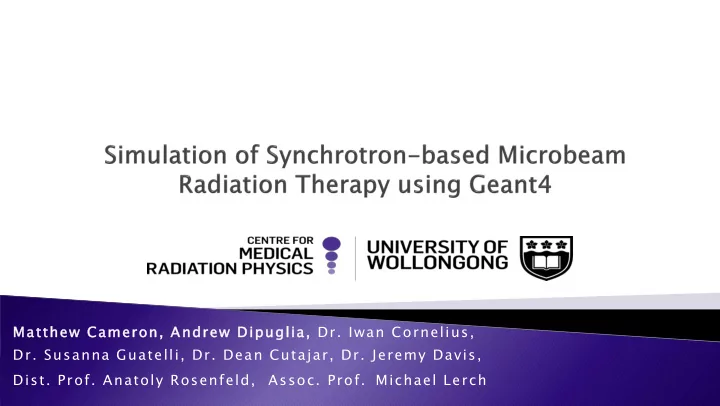

Matthew Cameron, Andrew Dipuglia, Dr. Iwan Cornelius, Dr. Susanna Guatelli, Dr. Dean Cutajar, Dr. Jeremy Davis, Dist. Prof. Anatoly Rosenfeld, Assoc. Prof. Michael Lerch
Australian Synchrotron High intensity (up to 10kGy/s) , low Preferential damage to tumors divergence, polarised, pulsed photon beam Preclinical research, promising for paediatric Use of micron sized beams to deposit very patients, head and neck tumors, other radiosensitive tumors large doses Braüer-Krisch, E. Serduc, R. Siegbahn, et al. 2010. Laissue, J. Blattmann, H. Grotzer, M. Slatkin, D. 2007. Develp. Mutat . Res. 704. 160-166. Med. Child Neurol. 49, 577-581.
Development of Geant4 simulations for characterisation of 150 um detectors designed ◦ At the Centre For Medical Radiation Physics, University of Wollongong ◦ for use in Quality Assurance of Microbeam Radiation Therapy (MRT) at the Australian Synchrotron Imaging and Medical Beamline (IMBL) 20 um 30 um Requirements: ◦ Modular design – experiments have differing beamline configuration ◦ Geant4 based ◦ Time-dependent geometry – mimic experimental phantom motion ◦ Efficient – maximum accuracy for minimum execution time
Cornelius, I. Fournier, P. Guatelli, S. et. al. 2014. J Sync. Rad. 21 . 518-528.
Phase Space Position, Momentum, Polarisation, Energy, Weighting High Dose e Rate (HDR) Medium Dose e Rate (MDR) Low Dose e Rate (LDR) Beam energy range ~50keV-300keV Beam average energy: 100keV Filter 1 C (0.45 mm) Beam size: 10mm x 10mm Filter 2 C (1.49 mm) 45 º Using low energy livermore polarized physics model. “ Benchmarking and validation of a Geant4-SHADOW MC simulation for dose calculations in MRT ” Filter 3 C (10 mm) 45 º Filter 4 Al (2 mm) 45º Cu (1 mm) 45 º Al (2 mm) 45 º Filter 5 Cu (1 mm) 45 º Cu (1 mm) 45 º Mo (2 mm) 45 º Livermore Polarised Physics, Geant4 9.6.patch4
Find the best steering angle of e - to maximise the intensity of the photons ◦ W.r.t. magnetic field Optimisation of the photon splitting w in G4Synchrotron: ◦ Increase photon generation per step in wiggler ◦ Optimised to w=5000 1 ◦ The photon is recorded in the PSF with weighing number of 𝑜𝑣𝑛𝑐𝑓𝑠_𝑓𝑚𝑓𝑑𝑢𝑠𝑝𝑜𝑡_𝑘𝑝𝑐 ∙ 𝑥 e- Y=0 θ B=3,2,1.4
Photon intensity map 10 cm from Phantom Pixel size= 0.1x0.1 mm 2
Wiggle gler Field Streng ngth th Elect ctro ron n Steering ring Angle le (T) (T) (deg) 3.0 -0.140 2.0 -0.093 1.4 -0.065 3.0 T steering angle = -0.140 deg 1.4 T steering angle = -0.065 deg
Stevenson et al. 2017. J. Sync. Rad. 24. 110-141. 2.0T HDR ~70keV mean 3.0T MDR ~90keV mean
1 x 0.01 x 0.1 mm 3 resolution 1 x 1 x 1 mm 3 resolution Microbeam Broad beam
Broadbeam configuration Stage I PSF filling: variable depending on beam defining aperture size - 4800 hrs in total (~ 200 days) Stage II edep for broad beam configuration: ~50 hours Microbeam configuration (with multislit collimator) Stage I: ~1600 days Stage II: ~100 hours Supercomputing facility: Massive, Monash or Raijin, NCI, Canberra
An entirely Geant4-based model of the Australian Synchrotron IMBL has been developed Good agreement of simulated energy spectra against reference analytical data Benchmarking in progress against experimental Ion Chamber and GafChromic film measurements for a variety of configurations Future work includes: ◦ Investigation into 4T mode ◦ Migration to Geant4 Multithreaded ◦ Test alternative physics lists of Geant4 – how polarisation affects the simulation results ◦ Test the polarisation models of Geant4
A/Prof Michael Lerch Dist. Prof Anatoly Dr Iwan Dr. Susanna Guatelli Dr. Jeremy Davis Dr Dean Cutajar Rozenfeld Cornelius Matthew Cameron Andrew Dipuglia
MDR Std. Dev. Max Angle le Mean n Of the Relati ative ve (deg) Energ rgy Mean Intens nsity ty (keV) (keV) ) (%) -0.02 74.77 14.32 11.58 -0.05 78.73 16.70 54.95 -0.09 80.30 17.75 100.0 -0.13 78.20 16.66 61.45
Recommend
More recommend